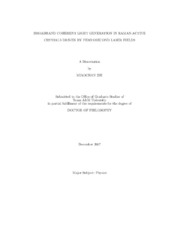| dc.description.abstract | I studied a family of closely connected topics related to the production and application
of ultrashort laser pulses. I achieved broadband cascade Raman generation
in crystals, producing mutually coherent frequency sidebands which can possibly be
used to synthesize optical pulses as short as a fraction of a femtosecond (fs). Unlike
generation using gases, there is no need for a cumbersome vacuum system when
working with room temperature crystals. Our method, therefore, shows promise for
a compact system.
One problem for sideband generation in solids is phase matching, because the
dispersion is significant. I solved this problem by using non-collinear geometry. I
observed what to our knowledge is a record-large number of spectral sidebands generated
in a popular Raman crystal PbWO4 covering infrared, visible, and ultraviolet
spectral regions, when I applied two 50 fs laser pulses tuned close to the Raman
resonance. Similar generation in diamond was also observed, which shows that the
method is universal. When a third probe pulse is applied, a very interesting 2-D color
array is generated in both crystals.
As many as 40 anti-Stokes and 5 Stokes sidebands are generated when a pair of
time-delayed linear chirped pulses are applied to the PbWO4 crystal. This shows that
pulses with picosecond duration, which is on the order of the coherence decay time,
is more effective for sidebands generation than Fourier transform limited fs pulses. I also studied the technique of fs coherent Raman anti-Stokes scattering (CARS)
which is used as a tool for detecting dipicolinic acid, the marker molecule for bacterial
spores. I observed that there is a maximum when the concentration dependence of
the near-resonant CARS signal is measured. I presented a model to describe this
behavior, and found an analytical solution that agrees with our experimental data.
Theoretically, I explored a possible application for single-cycle pulses: laser induced
nuclear fusion. I performed both classical and quantum mechanical calculations
for a system of two nuclei moving under a superintense ultrashort field. From our
calculation I noted that the nuclear collisions occur on a sub-attosecond time scale,
and are predicted to result in an emission of zeptosecond bursts of light. | en |


